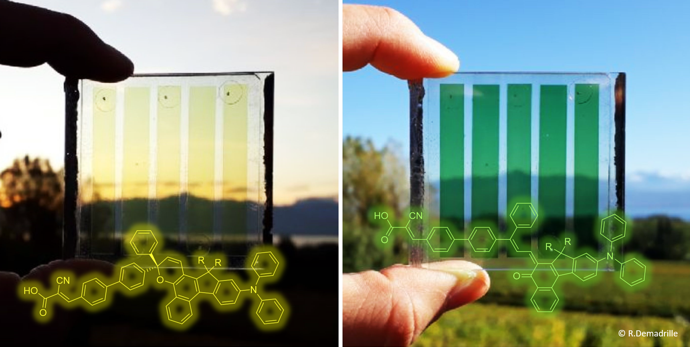The latest generations of solar cells, especially those incorporating organic materials, have the advantage of being semi-transparent. This property is of a great interest for the development of photovoltaic glasses that could be integrated into buildings or automobiles. However, a compromise between transparency and efficiency must always be found for these solar cells. For the integration of this type of semi-transparent devices in glass panes, the Grail would be that they can produce electricity while offering the possibility of automatically adjusting their light transmission according to the intensity of daylight. By developing solar cells based on new photochromic dyes, an IRIG team may have found the solution to this problem. Indeed, they developed photochromic dye-sensitized solar cells are highly transparent, but they darken in bright sunlight to produce electricity and lighten as soon as the sunlight fades.
In the last years, chemists have synthesized many organic molecules that are increasingly efficient to improve the performance of dye-sensitized solar cells. With these photo-sensitizing molecules, it is possible to develop colored and semi-transparent solar cells, some of them have been integrated into the facades of public buildings, such as in Switzerland at the EPFL
[1]. Unfortunately, the development of efficient semi-transparent photovoltaic devices remains a difficult task. Indeed, if one wants to achieve a good photovoltaic conversion efficiency, one has to absorb a lot of light, but strongly absorbing the light leads inexorably to deteriorate the transparency...
To meet the challenge of combining transparency and efficiency, we have proposed a new strategy based on the integration of photochromic molecules based on diphenyl-naphthopyrans into the dye sensitized solar cells. These molecules are capable of isomerizing under light exposure, which leads them to change color; they then return to their colorless form when light exposure ceases.
In our latest study published in the journal
Nature Energy
[2], we thus integrated a photochromic unit into the structure of various dyes and we were able to demonstrate that their photochromic behavior was preserved once integrated in the devices. Using these molecules, we have been able to manufacture and characterize solar cells and mini-modules that change color under light radiation from pale yellow to orange, red or dark green under high luminosity, increasing at the same time their photovoltaic conversion efficiency.

Photochromic solar cells change from light yellow to orange, red or even dark green under the effect of strong luminosity, while increasing their photovoltaic efficiency.
© Renaud Demadrille
The first photochromic solar cell prototypes produced in this way show a maximum power conversion efficiency of 4.1% while exhibiting a reversible color change under irradiation and a variation in transparency ranging from 69% to 27%. Finally, our preliminary results show that these photochromic solar cells can be stable for several months without encapsulation,
i.e. without any protection on the cell. Using this approach, we manufactured semi-transparent photochromic mini-modules with an active surface area of 14.08 cm
2 and a power output of 32.5 mW.
This work paves the way for the development of a new class of semi-transparent solar cells capable of changing color and showing self-adjusting light transmission. A first step towards photochromic photovoltaic windows.